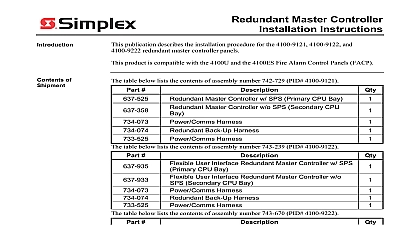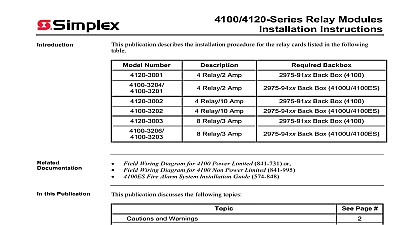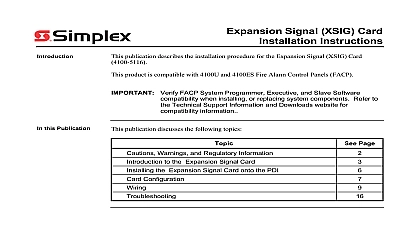Simplex Installation Instructions External Battery Charger

File Preview
Click below to download for free
Click below to download for free
File Data
| Name | simplex-installation-instructions-external-battery-charger-6143897205.pdf |
|---|---|
| Type | |
| Size | 799.34 KB |
| Downloads |
Text Preview
4081 9306 9308 Battery Chargers Instructions publication describes the installation procedure for an External Battery Charger used with the or 4100ES System Verify FACP System Programmer Executive and Slave Software when installing or replacing system components Refer to Technical Support Information and Downloads website for information this Publication publication discusses the following topics Page and Warnings Description the External Battery Charger and Wiring the External Battery Charger 2002 2011 SimplexGrinnell LP All rights reserved and other information shown were current as of publication and are subject to change without notice and the Simplex logo are trademarks of Tyco International Ltd and its affiliates and are used under license D and Warnings and AND SAVE THESE INSTRUCTIONS Follow the instructions in this installation These instructions must be followed to avoid damage to this product and associated Product operation and reliability depend upon proper installation NOT INSTALL ANY SIMPLEX PRODUCT THAT APPEARS DAMAGED Upon your Simplex product inspect the contents of the carton for shipping damage If is apparent immediately file a claim with the carrier and notify an authorized product supplier HAZARD Disconnect electrical field power when making any internal adjust or repairs All repairs should be performed by a representative or authorized agent of local Simplex product supplier SAFETY HAZARD Under certain fiber optic application conditions the optical output this device may exceed eye safety limits Do not use magnification such as a microscope other focusing equipment when viewing the output of this device HAZARD Static electricity can damage components Handle as follows yourself before opening or installing components to installation keep components wrapped in anti static material at all times RULES AND REGULATIONS PART 15 This equipment has been tested and found to with the limits for a Class A digital device pursuant to Part 15 of the FCC Rules limits are designed to provide reasonable protection against harmful interference when equipment is operated in a commercial environment This equipment generates uses and radiate radio frequency energy and if not installed and used in accordance with the manual may cause harmful interference to radio communications Operation of equipment in a residential area is likely to cause harmful interference in which case the will be required to correct the interference at his own expense REACCEPTANCE TEST AFTER SOFTWARE CHANGES To ensure proper operation this product must be tested in accordance with NFPA72 1996 Chapter 7 any programming operation or change in site specific software Reacceptance testing is after any change addition or deletion of system components or after any repair or adjustment to system hardware or wiring components circuits system operations or software functions known to be affected by a must be 100 tested In addition to ensure that other operations are not affected at least 10 of initiating devices that are not directly affected by the up to a maximum of 50 devices must also be tested and proper system operation Description external battery charger XBC consists of the battery charger PC board bracket assembly and external battery cabinet The external battery charger XBC is a communicating slave in a System A micro controller monitors all input and output functions on the charger is capable of reporting all board statuses to the system CPU via a 4100 style communications The XBC monitors and reports the following statuses Battery charger status Battery status Positive earth fault Negative earth fault AC fail the battery cabinet and charger are shown in Figure 1 Cabinet separately Assembly 1 Battery Cabinet and External Charger on next page Charger Board Description Continued Batteries XBC can re charge 55Ah 110Ah batteries per UL 864 and S527 requirements When discharged the batteries will demand a high current As the battery charges the rate charge will decrease The table below shows specific voltage and current information for both supply and output of the battery charger 1 System Voltage Ratings Current Range Amps 120VAC 4A Max 220 230 240VAC 2A Max Float Voltage DC 500mV 20 Voltage Output up to 7A charger voltage by battery charge state compensated at 5 50 temperature compensation the AC line drops below 85 of nominal brownout or AC fail the XBC will no charge the batteries It will continue to operate and communicate to the system however XBC is a temperature compensated battery charger It has no field adjustment The charger is higher when the temperature in the cabinet is low and lower when the temperature in the is high A warmer environment than that noted in the table above will result in a lower float voltage see Table 1 High Voltage Output shown above relates to the battery charger dual rate ability The high output kicks in when the batteries are discharged This allows battery capacity to be more quickly When the batteries become close to full the current will drop and the will switch back to the voltage on next page Description Continued charger controller board contains three LED indicators for signaling various troubles with the of the system They are used to indicate communications status power supply status AC power status respectively The tables below explain the trouble conditions of each LED 2 LED 1 COMMS Status Yellow CPU or if SW1 set that way 3 LED 2 Power Supply Status Blink Blink Blink Blink Earth Earth Trouble Trouble 4 LED 3 AC Power Green charger from AC Operating Temperature Ambient Conditions Outside the Cabinet 5 to 50 operation under non condensing humidity conditions up to 93 ULC humidity 38 FM spec the External Battery Charger External Battery Charger XBC is configured as part of a 4100 system in two steps must be programmed as part of the system Use the PC based 4100U or 4100ES to add the XBC to the system configuration This will assign a system address when communicating with the XBC Refer to the ES Panel Programmer Manual for instructions on adding the XBC to the system software configuration Adding XBC is similar to adding any other communicating slave to the system The physical configuration of the board must be set This includes setting the card address positioning the hardware jumpers on the card section explains how to configure the battery charger and includes an illustration referring to different components on the battery charger controller card Communications R49 for S527 P3 Rectifier 2 External Battery Charger Controller Card on next page the External Battery Charger Continued the External Battery Charger Continued External Battery Charger has two options that are jumper selectable the Earth Fault Monitor and the Depleted Battery Cutout Jumper Their functions are explained below Monitor XBC can be configured to monitor for earth faults When the XBC is not located with an or RPS it should be configured to monitor for earth faults Set jumper P3 at positions 1 and 2 to enable the monitoring of earth faults Set jumper P3 at positions 2 and 3 to disable the monitoring of earth faults e


